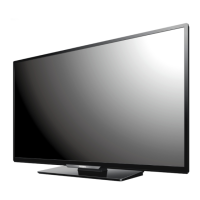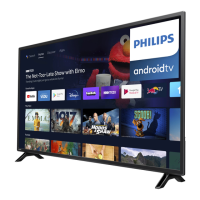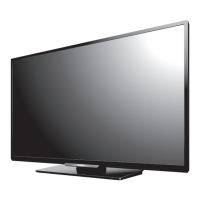
Do you have a question about the Philips 55PFL5602 and is the answer not in the manual?
Provides phone numbers for customer support in the US, Canada, Puerto Rico, and Mexico.
Explains caution and warning symbols used in the manual.
Essential advice on safe TV placement and handling to prevent injuries.
Guidance and precautions for securely mounting the TV on walls or ceilings.
Advises on safe placement and handling of older CRT televisions.
Essential instructions for safe operation and installation of the apparatus.
Guidelines for proper grounding of CATV systems as per NEC standards.
Critical safety advice and requirements for installing wall mount brackets.
Details product ownership, trademarks, and manufacturer's rights.
Outlines warranty terms, user-serviceable parts, and repair procedures.
FCC, Canadian IC, and other regulatory statements regarding radio frequency energy.
Discusses apparatus modifications, cable requirements, and compliance.
Guidelines for safely placing and handling the television to prevent tip-overs and damage.
Warnings about securing the apparatus and preventing tip-overs.
Advises on recycling packaging and proper disposal of the unit and batteries.
Instructions on how to pack the unit safely for moving or shipping.
Notes copyright information for included software components like FreeType.
Provides details on services like Netflix, VUDU, YouTube, Pandora, and CinemaNow.
Lists and explains trademarks and logos used on the TV and in the manual.
Lists and illustrates the items included with the TV set.
Describes the main functionalities and capabilities of the television.
Defines the meaning of symbols used throughout the user manual for clarity.
Step-by-step instructions for safely removing the TV from its packaging.
Detailed instructions for attaching the TV stands securely to the unit.
Instructions on how to lift and place the TV set onto a stable surface.
Guides on how to remove the cardboard attached to the screen before setup.
Step-by-step guide for inserting batteries into the remote control.
Detailed description of each button and its function on the remote control.
Explains the functions of the buttons located on the TV's control panel.
Details all input and output terminals available on the television set.
Guides on connecting various signal sources like antenna, cable, or set-top boxes.
Instructions on correctly plugging in the AC power cord after making connections.
Discusses different connection types and their quality levels: HDMI, Component, Composite.
Explains high-quality video and audio connection using HDMI cables.
Details connecting devices with DVI output using an HDMI-DVI cable.
How to use HDMI-ARC for audio output to compatible devices.
Connects devices using component video and analog audio cables.
Steps to connect the TV to the internet using a wired Ethernet connection.
Guides on connecting the TV to the internet wirelessly using a WLAN.
How to connect the TV to external digital audio devices for enhanced sound.
Connects the TV to a PC via HDMI or HDMI-DVI, with audio considerations.
Lists the video signal formats and resolutions compatible with PC input.
Instructions for connecting and selecting files from a USB memory stick.
Guides through initial setup including language, country, and autoprogram.
Instructions for setting up wireless or wired network connections.
How to turn the TV on from standby or off, and how to put it into standby mode.
Explains how to increase, decrease, or mute the TV's sound output.
Methods for changing channels using the remote control's CH +/- or number buttons.
How to switch between TV and connected external devices using the remote.
Steps to open and navigate the main Home menu for various functions.
How to lock/unlock devices, change device types, and scan connections.
How to create, display, and edit lists of preferred TV channels.
Explains how to select different display modes for 16:9 and 4:3 video signals.
How to view details like channel number, program title, and aspect ratio using the INFO button.
Details on picture formats for 4:3 video signals and PC input, including explanations of each mode.
How to navigate and use the Options menu for various settings.
Configures voice guide, captions, digital audio, and sound formats.
Operates linked HDMI devices like DVD players via the remote control.
Customizes picture and sound settings, including auto picture/sound and headphone volume.
Adjusts ECO settings, including the switch-off timer for power management.
Instructions for connecting and selecting files from a USB memory stick.
Lists the file formats and specifications supported for picture, music, and video playback.
Important notes and precautions regarding USB memory stick compatibility and usage.
How to start, pause, navigate, and stop photo slide shows and manage viewing options.
Options for voice guide, repeat, slide time, transitions, auto picture, rotate, and zoom for photos.
How to play, pause, skip, and stop music files, and adjust playback settings.
Settings for voice guide, repeat, shuffle, TV speakers, and auto sound for music.
How to play, pause, search, and stop movie playback, with resume functionality.
Options for voice guide, repeat, TV speakers, auto picture, and auto sound for movie playback.
Guides to optimizing picture and sound settings for the best viewing experience.
Accessing menus for picture, sound, and general TV usage settings.
Procedures for searching for and installing TV channels.
Guides for connecting the TV to your home network and configuring network settings.
Information on how to update the TV's software via USB or network.
Accessing and adjusting various software-related settings on the TV.
Introduces the setup process for picture and sound, requiring Home location for saved preferences.
Details how to adjust picture parameters like backlight, contrast, brightness, and color.
Describes various predefined picture modes like Standard, Vivid, and Movie for different viewing scenarios.
Covers settings like Pixel Plus HD, contrast enhancement, and picture format adjustments.
Adjusts enhancements for picture clarity, contrast, and motion smoothness.
Fine-tunes color, gamma, blue stretch, film mode, and HDR settings for optimal picture quality.
Adjusts color temperature and gain/offset for precise color representation.
Introduces sound settings, requiring Home location for saved preferences.
Explains various sound modes like Sonic Emotion, Bass Enhancement, and Absolute 3D Sound.
Manages TV speakers, headphone volume, digital audio output, and individual volume levels.
How to set the TV to automatically go into standby mode after a specified time.
How to choose the display language for the TV's on-screen menus.
Options for TV placement (wall mount/stand) and disabling the retail demo mode.
Explains how EasyLink enables one-touch control, playback, and audio management between compliant devices.
Details how HDMI-ARC on HDMI 2 outputs TV audio to connected audio devices.
How to operate linked devices and manage EasyLink functions like Auto TV On and RC key forwarding.
How to reset AV settings or all system settings to their original default values.
Configuration options for voice guide, caption settings, and digital audio preferences.
Settings for closed captions, including display modes and digital caption options.
Options to customize font, color, background, and edge characteristics of digital captions.
Important notes on caption display, including limitations and potential issues.
Settings for audio accessibility, language, and primary audio selection criteria.
Procedures for installing channels via antenna or cable, and uninstalling channels.
Guides on how to perform an automatic scan for available TV channels.
How to set up and use the child lock feature with a PIN code.
Configuring ratings to block programs based on age and content.
Setting parental ratings for Canadian English or French broadcasts.
Instructions for changing the default PIN code for parental controls.
How to select the preferred audio language for digital broadcasts.
Selecting audio format (Mono, Stereo, SAP) for analog TV reception.
Guides to setting up network connections for Net TV and software upgrades.
Steps to connect the TV to a wireless LAN using Easy Connect or manual entry.
Instructions for connecting the TV to the internet via an Ethernet cable.
Accessing network settings like connection test, status, and proxy configuration.
Setting up wireless connection via Auto, Easy Connect, Pin code, or Manual entry.
Choosing between wireless or wired connection types for the home network.
Steps to manually enter the wireless network name (SSID) and authentication settings.
Configuring IP address, subnet mask, gateway, DNS, and MAC address for network connection.
Setting up proxy server for internet access if required by the provider.
Performing tests to verify home network and internet connection status.
Viewing the current network settings and MAC address.
Using the TV as a Digital Media Renderer to play files from home media servers.
Configuring the TV to turn on remotely via IP control.
Managing settings for Net TV services like Netflix, YouTube, VUDU, and Samba TV.
Restoring network settings to their default values.
Lists required equipment and files for updating the TV software.
Instructions on how to download the latest software from the Philips website to a USB stick.
Step-by-step guide for upgrading the TV software using a USB memory stick.
How to update the TV software wirelessly through an internet connection.
Accessing software settings, checking version, and managing update notifications.
Information on software licenses and digital rights management used in the product.
How to wirelessly cast or mirror device screens to the TV.
Playing video, music, and photos from home media servers over the network.
Finding and managing connected devices in the Wireless Screencasting device list.
Steps to connect the TV to the internet and set up network settings for home network access.
How to access and browse files from home media servers using the TV interface.
How to play, pause, skip music files and adjust playback settings.
How to play, pause, search, and stop video files, with playback settings.
Accessing and browsing internet services offered through Net TV.
How to remove or move applications within the My Apps list.
Finding and adding new net services from the App Gallery.
Links to third-party service providers for detailed information on internet services.
Steps to create a Pandora account and activate the unit for streaming.
How to add Pandora user accounts to the TV.
Steps to create new stations based on artists or tracks and start playback.
Explains the interface and controls for the Pandora playback screen.
Solutions for common problems with the remote control not working.
Addressing issues with repeated initial setup and inability to watch RF signal programs.
Troubleshooting no image, automatic channel changes, and delayed/incomplete captions.
Resolving issues with forgotten PIN codes and repeated software update prompts.
Solutions for power-related problems and non-functional remote controls.
Addresses issues like no image, incorrect color, poor picture quality, pixelation, and distorted visuals.
Troubleshooting no sound, distorted audio, intermittent sound, and volume level problems.
Resolving problems with HDMI connections, distorted pictures, and interference.
Guidance on forgotten PIN codes, screen size changes, and color issues.
Resolving problems with closed captions, black boxes, and software update prompts.
Solutions for issues with connecting to the network, poor wireless quality, and connection failures.
Troubleshooting Netflix, VUDU, Pandora, and streaming quality problems.
Addressing potential compatibility issues with wireless screencasting devices.
Definitions of technical terms and acronyms used in the manual.
Guidelines for cleaning the TV exterior and procedures for seeking professional service.
Method to test if the remote control is emitting an infrared signal.
Details on picture type, screen size, viewing angles, tuner, sound, and power output.
Lists available ports like HDMI, USB, Ethernet, and audio/video inputs.
Information on power requirements and operating temperature range.
Outlines the terms, coverage, and duration of the product's limited warranty.
Details what is not covered by the warranty, including exclusions and limitations.
Instructions on how to contact customer support for warranty service and repairs.
Information on obtaining source code for copyrighted open source packages used in the product.












